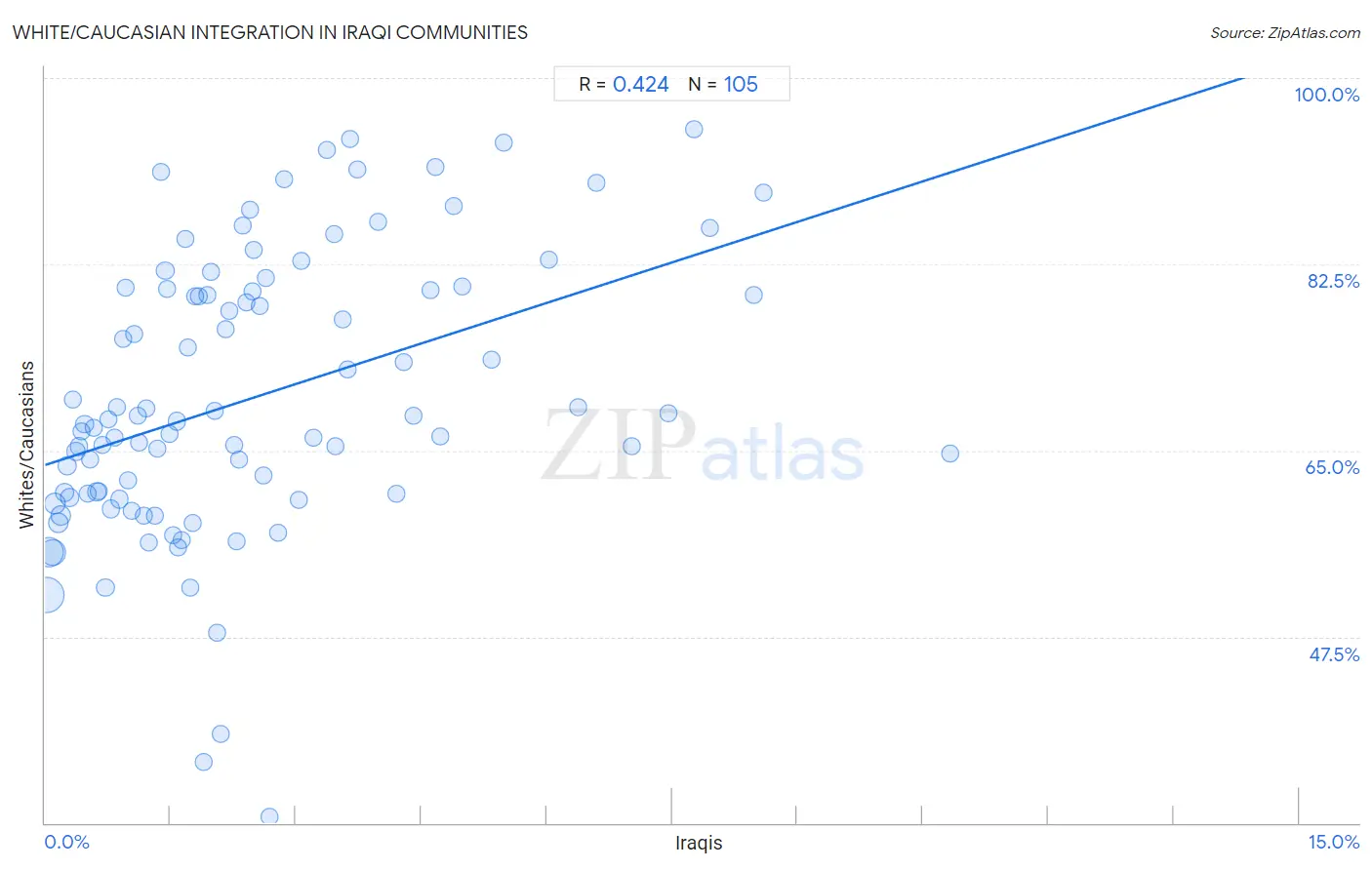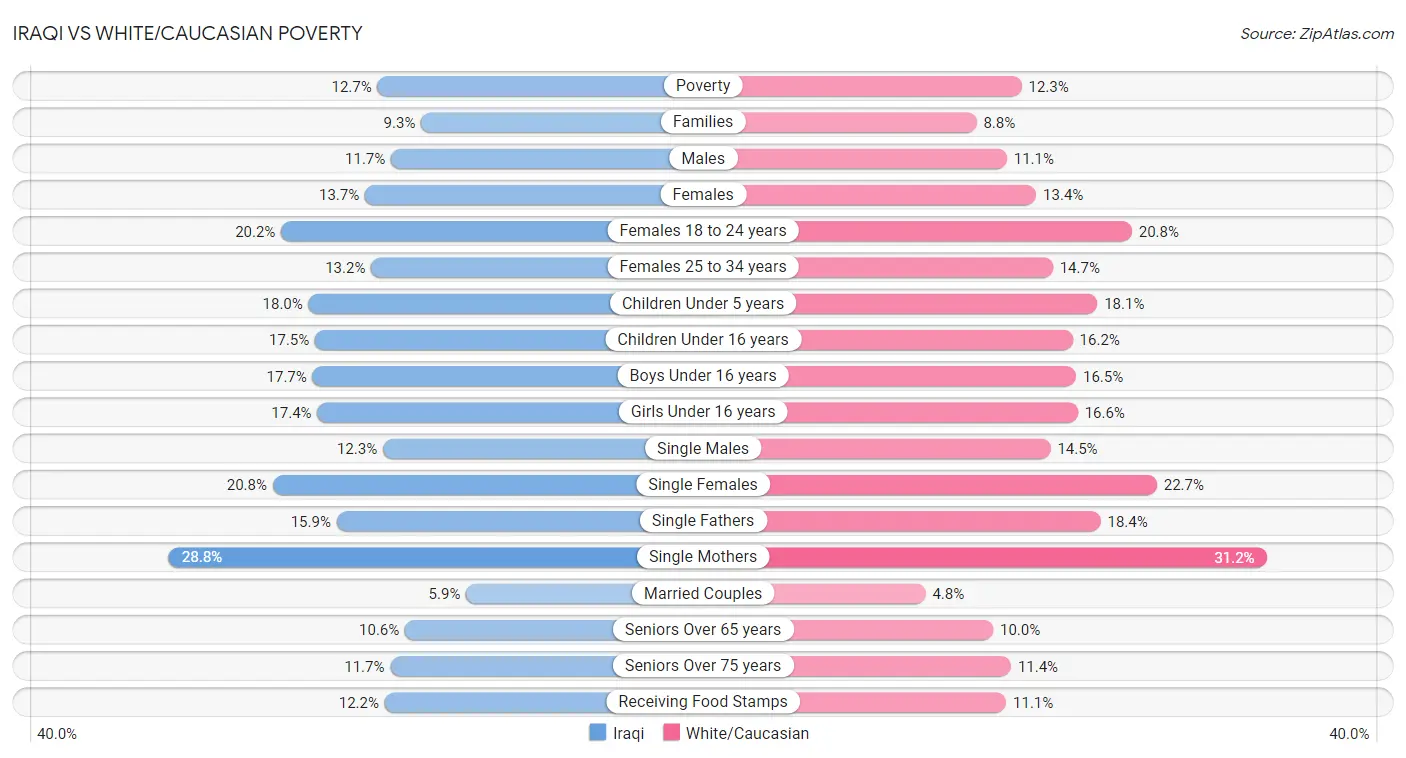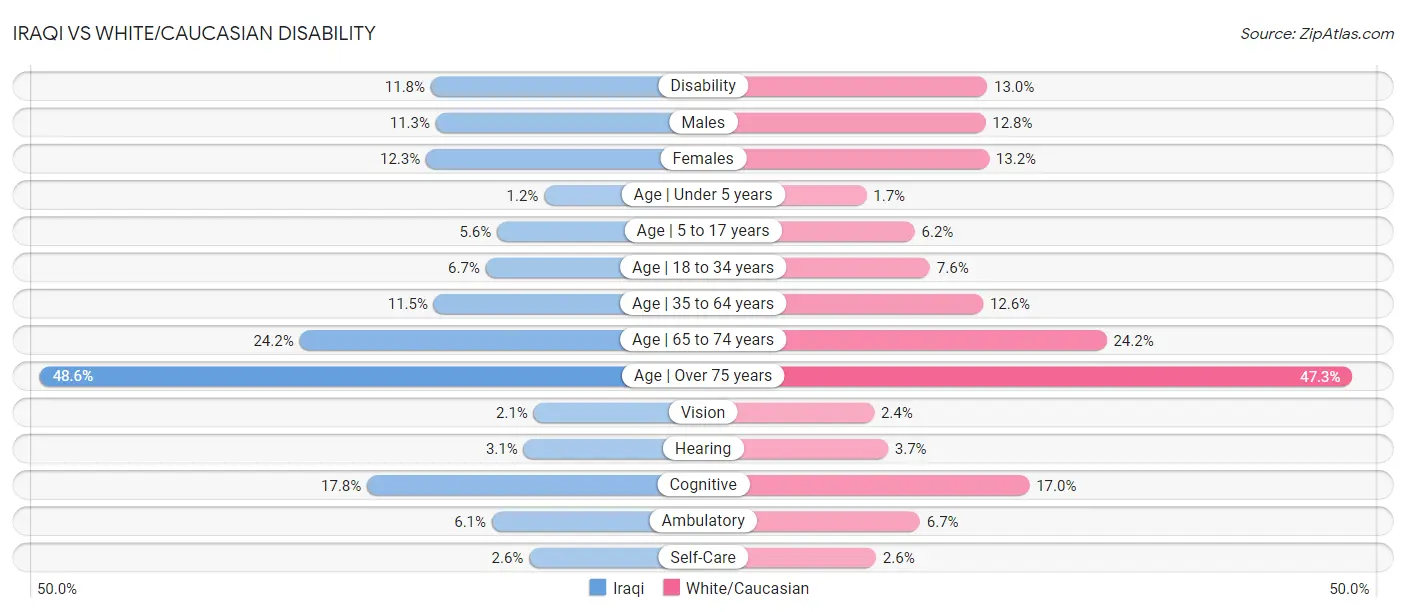Iraqi vs White/Caucasian Community Comparison
COMPARE
Iraqi
White/Caucasian
Social Comparison
Social Comparison
Iraqis
Whites/Caucasians
5,167
SOCIAL INDEX
49.2/ 100
SOCIAL RATING
183rd/ 347
SOCIAL RANK
5,140
SOCIAL INDEX
48.9/ 100
SOCIAL RATING
185th/ 347
SOCIAL RANK
White/Caucasian Integration in Iraqi Communities
The statistical analysis conducted on geographies consisting of 170,639,788 people shows a moderate positive correlation between the proportion of Whites/Caucasians within Iraqi communities in the United States with a correlation coefficient (R) of 0.424. On average, for every 1% (one percent) increase in Iraqis within a typical geography, there is an increase of 2.539% in Whites/Caucasians. To illustrate, in a geography comprising of 100,000 individuals, a rise of 1,000 Iraqis corresponds to an increase of 2,538.8 Whites/Caucasians.

Iraqi vs White/Caucasian Income
When considering income, the most significant differences between Iraqi and White/Caucasian communities in the United States are seen in wage/income gap (26.6% compared to 28.5%, a difference of 7.0%), median female earnings ($38,666 compared to $37,531, a difference of 3.0%), and householder income over 65 years ($60,466 compared to $58,847, a difference of 2.8%). Conversely, both communities are more comparable in terms of median male earnings ($54,182 compared to $53,925, a difference of 0.48%), median family income ($100,658 compared to $99,800, a difference of 0.86%), and householder income under 25 years ($50,802 compared to $50,336, a difference of 0.93%).

| Income Metric | Iraqi | White/Caucasian |
| Per Capita Income | Fair $42,760 | Poor $42,180 |
| Median Family Income | Fair $100,658 | Poor $99,800 |
| Median Household Income | Fair $83,753 | Poor $82,029 |
| Median Earnings | Fair $46,140 | Poor $45,197 |
| Median Male Earnings | Average $54,182 | Fair $53,925 |
| Median Female Earnings | Poor $38,666 | Tragic $37,531 |
| Householder Age | Under 25 years | Tragic $50,802 | Tragic $50,336 |
| Householder Age | 25 - 44 years | Poor $90,764 | Poor $91,668 |
| Householder Age | 45 - 64 years | Fair $99,387 | Fair $98,091 |
| Householder Age | Over 65 years | Fair $60,466 | Tragic $58,847 |
| Wage/Income Gap | Poor 26.6% | Tragic 28.5% |
Iraqi vs White/Caucasian Poverty
When considering poverty, the most significant differences between Iraqi and White/Caucasian communities in the United States are seen in married-couple family poverty (5.9% compared to 4.8%, a difference of 21.6%), single male poverty (12.3% compared to 14.5%, a difference of 17.8%), and single father poverty (15.9% compared to 18.4%, a difference of 15.6%). Conversely, both communities are more comparable in terms of child poverty under the age of 5 (18.0% compared to 18.1%, a difference of 0.30%), female poverty (13.7% compared to 13.4%, a difference of 2.3%), and seniors poverty over the age of 75 (11.7% compared to 11.4%, a difference of 2.6%).

| Poverty Metric | Iraqi | White/Caucasian |
| Poverty | Fair 12.7% | Average 12.3% |
| Families | Fair 9.3% | Good 8.8% |
| Males | Poor 11.7% | Average 11.1% |
| Females | Fair 13.7% | Average 13.4% |
| Females 18 to 24 years | Average 20.2% | Tragic 20.8% |
| Females 25 to 34 years | Good 13.2% | Tragic 14.7% |
| Children Under 5 years | Poor 18.0% | Poor 18.1% |
| Children Under 16 years | Tragic 17.5% | Average 16.2% |
| Boys Under 16 years | Tragic 17.7% | Average 16.5% |
| Girls Under 16 years | Poor 17.4% | Average 16.6% |
| Single Males | Exceptional 12.3% | Tragic 14.5% |
| Single Females | Good 20.8% | Tragic 22.7% |
| Single Fathers | Exceptional 15.9% | Tragic 18.4% |
| Single Mothers | Good 28.8% | Tragic 31.2% |
| Married Couples | Tragic 5.9% | Exceptional 4.8% |
| Seniors Over 65 years | Excellent 10.6% | Exceptional 10.0% |
| Seniors Over 75 years | Excellent 11.7% | Exceptional 11.4% |
| Receiving Food Stamps | Fair 12.2% | Excellent 11.1% |
Iraqi vs White/Caucasian Unemployment
When considering unemployment, the most significant differences between Iraqi and White/Caucasian communities in the United States are seen in unemployment among women with children ages 6 to 17 years (8.4% compared to 9.6%, a difference of 14.8%), unemployment among women with children under 6 years (7.3% compared to 8.4%, a difference of 14.6%), and female unemployment (5.5% compared to 4.9%, a difference of 11.7%). Conversely, both communities are more comparable in terms of unemployment among ages 55 to 59 years (4.7% compared to 4.7%, a difference of 0.96%), unemployment among ages 35 to 44 years (4.7% compared to 4.6%, a difference of 1.0%), and unemployment among seniors over 75 years (9.9% compared to 10.1%, a difference of 1.5%).

| Unemployment Metric | Iraqi | White/Caucasian |
| Unemployment | Poor 5.4% | Exceptional 4.9% |
| Males | Fair 5.4% | Exceptional 5.0% |
| Females | Tragic 5.5% | Exceptional 4.9% |
| Youth < 25 | Good 11.5% | Exceptional 11.2% |
| Age | 16 to 19 years | Exceptional 16.4% | Exceptional 16.8% |
| Age | 20 to 24 years | Average 10.3% | Excellent 10.1% |
| Age | 25 to 29 years | Exceptional 6.4% | Poor 6.9% |
| Age | 30 to 34 years | Exceptional 5.2% | Tragic 5.7% |
| Age | 35 to 44 years | Average 4.7% | Good 4.6% |
| Age | 45 to 54 years | Tragic 4.7% | Exceptional 4.3% |
| Age | 55 to 59 years | Exceptional 4.7% | Exceptional 4.7% |
| Age | 60 to 64 years | Exceptional 4.5% | Exceptional 4.7% |
| Age | 65 to 74 years | Exceptional 4.9% | Average 5.4% |
| Seniors > 65 | Exceptional 4.7% | Excellent 5.1% |
| Seniors > 75 | Tragic 9.9% | Tragic 10.1% |
| Women w/ Children < 6 | Exceptional 7.3% | Tragic 8.4% |
| Women w/ Children 6 to 17 | Exceptional 8.4% | Tragic 9.6% |
| Women w/ Children < 18 | Fair 5.5% | Excellent 5.3% |
Iraqi vs White/Caucasian Labor Participation
When considering labor participation, the most significant differences between Iraqi and White/Caucasian communities in the United States are seen in in labor force | age 16-19 (38.6% compared to 41.3%, a difference of 7.0%), in labor force | age > 16 (65.7% compared to 63.6%, a difference of 3.3%), and in labor force | age 20-24 (76.0% compared to 76.9%, a difference of 1.3%). Conversely, both communities are more comparable in terms of in labor force | age 30-34 (83.8% compared to 83.9%, a difference of 0.060%), in labor force | age 35-44 (83.8% compared to 83.6%, a difference of 0.16%), and in labor force | age 25-29 (83.9% compared to 84.2%, a difference of 0.31%).

| Labor Participation Metric | Iraqi | White/Caucasian |
| In Labor Force | Age > 16 | Exceptional 65.7% | Tragic 63.6% |
| In Labor Force | Age 20-64 | Poor 79.3% | Tragic 78.5% |
| In Labor Force | Age 16-19 | Exceptional 38.6% | Exceptional 41.3% |
| In Labor Force | Age 20-24 | Exceptional 76.0% | Exceptional 76.9% |
| In Labor Force | Age 25-29 | Tragic 83.9% | Tragic 84.2% |
| In Labor Force | Age 30-34 | Tragic 83.8% | Tragic 83.9% |
| In Labor Force | Age 35-44 | Tragic 83.8% | Tragic 83.6% |
| In Labor Force | Age 45-54 | Tragic 82.2% | Tragic 81.9% |
Iraqi vs White/Caucasian Family Structure
When considering family structure, the most significant differences between Iraqi and White/Caucasian communities in the United States are seen in births to unmarried women (27.6% compared to 33.3%, a difference of 20.7%), single father households (2.2% compared to 2.4%, a difference of 10.4%), and divorced or separated (11.8% compared to 12.6%, a difference of 7.3%). Conversely, both communities are more comparable in terms of single mother households (6.1% compared to 6.1%, a difference of 0.53%), family households (64.4% compared to 65.1%, a difference of 1.1%), and average family size (3.24 compared to 3.14, a difference of 2.9%).

| Family Structure Metric | Iraqi | White/Caucasian |
| Family Households | Average 64.4% | Exceptional 65.1% |
| Family Households with Children | Exceptional 28.5% | Average 27.4% |
| Married-couple Households | Good 46.9% | Exceptional 48.6% |
| Average Family Size | Good 3.24 | Tragic 3.14 |
| Single Father Households | Exceptional 2.2% | Fair 2.4% |
| Single Mother Households | Good 6.1% | Good 6.1% |
| Currently Married | Good 46.9% | Exceptional 48.6% |
| Divorced or Separated | Exceptional 11.8% | Tragic 12.6% |
| Births to Unmarried Women | Exceptional 27.6% | Poor 33.3% |
Iraqi vs White/Caucasian Vehicle Availability
When considering vehicle availability, the most significant differences between Iraqi and White/Caucasian communities in the United States are seen in 4 or more vehicles in household (6.2% compared to 7.4%, a difference of 18.0%), 3 or more vehicles in household (19.6% compared to 22.6%, a difference of 15.3%), and no vehicles in household (7.7% compared to 7.0%, a difference of 10.1%). Conversely, both communities are more comparable in terms of 1 or more vehicles in household (91.9% compared to 93.1%, a difference of 1.3%), 2 or more vehicles in household (57.1% compared to 60.8%, a difference of 6.6%), and no vehicles in household (7.7% compared to 7.0%, a difference of 10.1%).

| Vehicle Availability Metric | Iraqi | White/Caucasian |
| No Vehicles Available | Exceptional 7.7% | Exceptional 7.0% |
| 1+ Vehicles Available | Exceptional 91.9% | Exceptional 93.1% |
| 2+ Vehicles Available | Exceptional 57.1% | Exceptional 60.8% |
| 3+ Vehicles Available | Average 19.6% | Exceptional 22.6% |
| 4+ Vehicles Available | Fair 6.2% | Exceptional 7.4% |
Iraqi vs White/Caucasian Education Level
When considering education level, the most significant differences between Iraqi and White/Caucasian communities in the United States are seen in no schooling completed (2.4% compared to 1.6%, a difference of 44.7%), master's degree (15.5% compared to 13.8%, a difference of 12.2%), and professional degree (4.5% compared to 4.1%, a difference of 11.5%). Conversely, both communities are more comparable in terms of ged/equivalency (86.2% compared to 86.2%, a difference of 0.080%), 12th grade, no diploma (91.5% compared to 91.8%, a difference of 0.39%), and 11th grade (92.8% compared to 93.3%, a difference of 0.63%).

| Education Level Metric | Iraqi | White/Caucasian |
| No Schooling Completed | Tragic 2.4% | Exceptional 1.6% |
| Nursery School | Tragic 97.7% | Exceptional 98.5% |
| Kindergarten | Tragic 97.7% | Exceptional 98.4% |
| 1st Grade | Tragic 97.7% | Exceptional 98.4% |
| 2nd Grade | Tragic 97.6% | Exceptional 98.4% |
| 3rd Grade | Tragic 97.5% | Exceptional 98.3% |
| 4th Grade | Tragic 97.3% | Exceptional 98.1% |
| 5th Grade | Poor 97.1% | Exceptional 97.9% |
| 6th Grade | Poor 96.8% | Exceptional 97.7% |
| 7th Grade | Average 96.0% | Exceptional 97.0% |
| 8th Grade | Average 95.7% | Exceptional 96.7% |
| 9th Grade | Average 94.9% | Exceptional 95.8% |
| 10th Grade | Good 93.9% | Exceptional 94.7% |
| 11th Grade | Good 92.8% | Exceptional 93.3% |
| 12th Grade, No Diploma | Good 91.5% | Exceptional 91.8% |
| High School Diploma | Good 89.5% | Exceptional 90.1% |
| GED/Equivalency | Good 86.2% | Good 86.2% |
| College, Under 1 year | Excellent 66.8% | Poor 64.0% |
| College, 1 year or more | Excellent 60.7% | Tragic 57.6% |
| Associate's Degree | Good 47.4% | Tragic 44.2% |
| Bachelor's Degree | Good 39.0% | Tragic 35.3% |
| Master's Degree | Good 15.5% | Tragic 13.8% |
| Professional Degree | Good 4.5% | Poor 4.1% |
| Doctorate Degree | Average 1.8% | Fair 1.8% |
Iraqi vs White/Caucasian Disability
When considering disability, the most significant differences between Iraqi and White/Caucasian communities in the United States are seen in disability age under 5 (1.2% compared to 1.7%, a difference of 43.5%), hearing disability (3.1% compared to 3.7%, a difference of 19.0%), and disability age 18 to 34 (6.7% compared to 7.6%, a difference of 14.7%). Conversely, both communities are more comparable in terms of disability age 65 to 74 (24.2% compared to 24.2%, a difference of 0.31%), self-care disability (2.6% compared to 2.6%, a difference of 0.40%), and disability age over 75 (48.6% compared to 47.3%, a difference of 2.6%).

| Disability Metric | Iraqi | White/Caucasian |
| Disability | Fair 11.8% | Tragic 13.0% |
| Males | Fair 11.3% | Tragic 12.8% |
| Females | Fair 12.3% | Tragic 13.2% |
| Age | Under 5 years | Exceptional 1.2% | Tragic 1.7% |
| Age | 5 to 17 years | Average 5.6% | Tragic 6.2% |
| Age | 18 to 34 years | Fair 6.7% | Tragic 7.6% |
| Age | 35 to 64 years | Fair 11.5% | Tragic 12.6% |
| Age | 65 to 74 years | Tragic 24.2% | Tragic 24.2% |
| Age | Over 75 years | Tragic 48.6% | Average 47.3% |
| Vision | Good 2.1% | Tragic 2.4% |
| Hearing | Poor 3.1% | Tragic 3.7% |
| Cognitive | Tragic 17.8% | Exceptional 17.0% |
| Ambulatory | Good 6.1% | Tragic 6.7% |
| Self-Care | Tragic 2.6% | Tragic 2.6% |